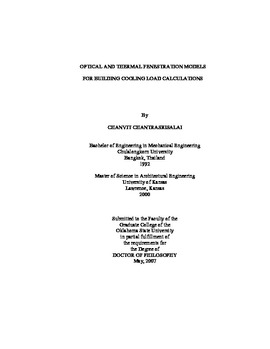| dc.contributor.advisor | Fisher, Daniel E. | |
| dc.contributor.author | Chantrasrisalai, Chanvit | |
| dc.date.accessioned | 2013-12-10T18:05:14Z | |
| dc.date.available | 2013-12-10T18:05:14Z | |
| dc.date.issued | 2007-05 | |
| dc.identifier.uri | https://hdl.handle.net/11244/7788 | |
| dc.description.abstract | Scope and Method of Study: The objective of this study was to enhance the modeling of fenestration systems containing shading devices for building thermal load and energy calculations. The focus was on the simulation of the fenestration system containing a slat-type blind. Two optical models were developed: one for predicting the blind optical properties (called the comprehensive blind model) and one for predicting the overall optical properties of the fenestration system. An in situ experimental method was also developed to measure solar-optical properties of installed fenestration systems. Two thermal models were also developed: one suitable for the Heat Balance load calculation method and one suitable for the Radiant Time Series load calculation method. The thermal models are applicable to the fenestration system containing the interior blind only. In addition, an experimental method was developed to measure the thermal parameters required by the thermal models. | |
| dc.description.abstract | Findings and Conclusions: The comprehensive blind model was compared to existing optical blind models (the Parmelee and Pfrommer models) and was compared with measured data obtained by the in situ experimental method. Overall, the comprehensive blind model consistently agreed quite well with measured data for diffusely reflecting blinds. The comprehensive blind model had slightly better agreements with measured diffuse solar transmittance than both the Parmelee and Pfrommer models did. For total solar transmittance, the comprehensive blind model showed better agreements with measured data than the Pfrommer model did. The comprehensive blind model agreed significantly better with measured total solar transmittance than the Parmelee model did when a large amount of direct solar radiation was directly transmitted without any reflections. However, the Parmelee model tended to do slightly better when a large amount of direct solar radiation was transmitted by reflections. In summary, the comprehensive blind model has been both verified and experimentally validated. | |
| dc.description.abstract | A limited set of experiments were conducted to demonstrate the feasibility of supporting the thermal models with measured data. An uncertainty analysis was used to estimate the accuracy of the experimental results. Good agreements between calculated and measured surface temperatures were used to support the validity of primary experimental measurements. Good agreements between measured data and published numerical results were then used to demonstrate that the proposed experimental method can capture the effect of an experimental variable on the thermal parameters. In addition, the evaluation of the experimental variable effects was used to provide information useful for the development of empirical correlations of the thermal parameters. | |
| dc.format | application/pdf | |
| dc.language | en_US | |
| dc.rights | Copyright is held by the author who has granted the Oklahoma State University Library the non-exclusive right to share this material in its institutional repository. Contact Digital Library Services at lib-dls@okstate.edu or 405-744-9161 for the permission policy on the use, reproduction or distribution of this material. | |
| dc.title | Optical and thermal fenestration models for building cooling load calculations | |
| dc.contributor.committeeMember | Spitler, Jeffrey D. | |
| dc.contributor.committeeMember | Ghajar, Afshin J. | |
| dc.contributor.committeeMember | Mansy, Khaled | |
| osu.filename | Chantrasrisalai_okstate_0664D_2195.pdf | |
| osu.accesstype | Open Access | |
| dc.type.genre | Dissertation | |
| dc.type.material | Text | |
| thesis.degree.discipline | Mechanical Engineering | |
| thesis.degree.grantor | Oklahoma State University | |
